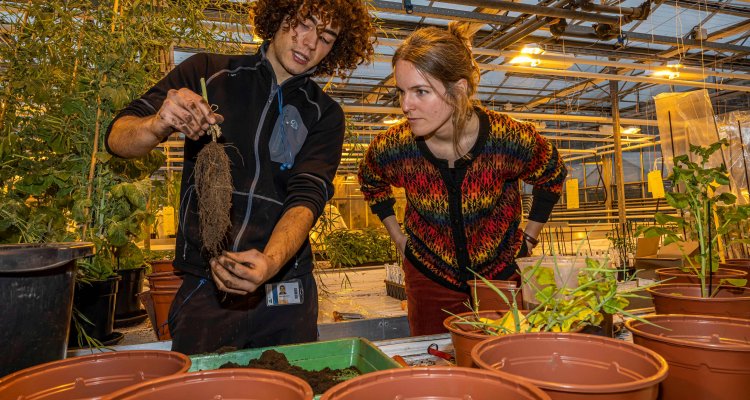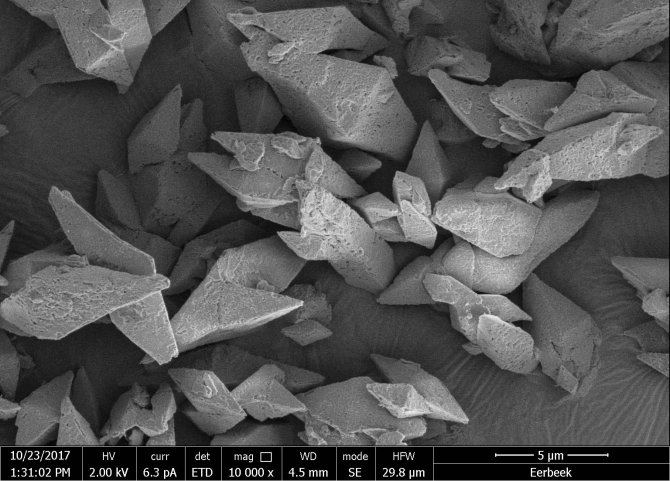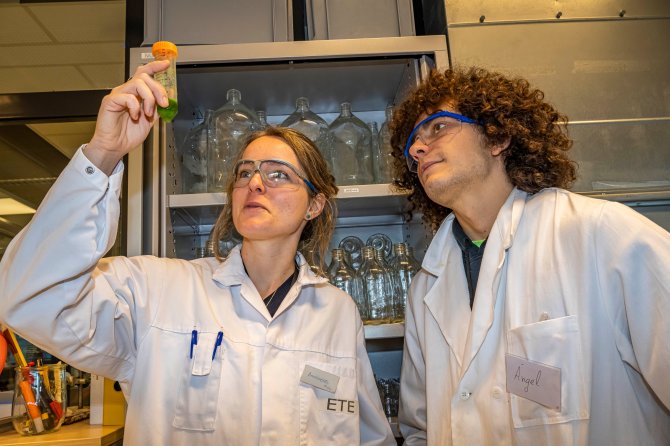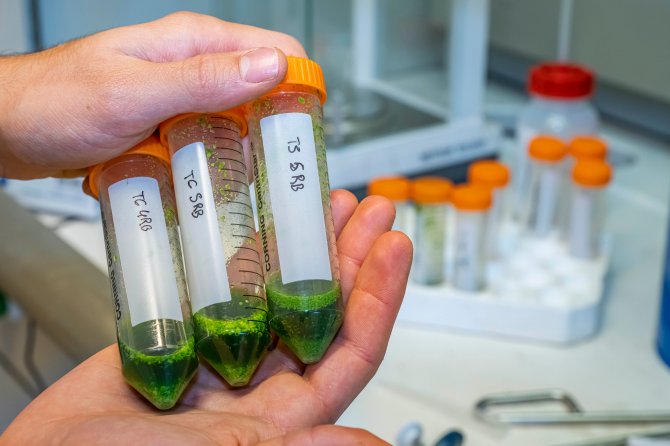
News
Using bio-sulfur as fertilizer in agriculture
Sulfur can be recovered from wastewater as well as gas streams using microorganisms, resulting in elemental sulfur. However, the reuse of this biologically produced sulfur is not always easy. However, sulfur is an essential nutrient for plants, and may therefore have great potential as a fertilizer in agriculture. Annemerel Mol, Assistant Professor at ETE, is investigating how to efficiently apply recovered bio-sulfur as fertilizer in agriculture to encourage sulfur reuse and close cycles.
The lights in the greenhouse of ‘Nergena’, Wageningen UR’s plant experimental facility, shrouds everything in a yellowish glow. Annemerel Mol and MSc student Ángel Cimas Quero, are harvesting plants from their experiment that just ended. They collect the leaves and roots and weigh the different plant parts. ‘In this plant experiment, we are investigating if this cabbage species grows well if we replace sulfate (SO42-), present in artificial fertilizer, with bio-sulfur, recovered from natural gas’, Annemerel Mol says. ‘We measure the plant’s size, but also check it’s health by quantifying the pigments present, for example chlorophylls. We also look at the size and color of the flowers.’ If the plant receives too little nutrients, like sulfur for example, some pigments may decrease, the roots will grow relatively big, trying to absorb more nutrients, while also the flowers will suffer: they remain smaller and often are white instead of yellow. If the experiment is successful, recovered bio-sulfur may have a future application as fertilizer in the agricultural industry, increasing its value, while making recycling easier.
Reduction of emissions
Sulfur recovery with microorganism from fuels, like natural gas, is a well-established technology, that has been developed by Professor Cees Buisman in the 1990’s. After the removal of sulfur, fuels are cleaner, resulting in a strong reduction of sulfur oxide (SO2) emissions when these fuels are burnt. Excessive atmospheric SO2 was once one of the causes of acid rain, due to its conversion into sulfuric acid (H2SO4). ‘During the last 20 years, sulfur emissions have reduced substantially, due to these cleaner fuels’, Mol explains. ‘As a result, acid rain is largely a thing of the past, while deposition of sulfur-compounds has decreased as well.’ However, the success of clean fuels results in a sulfur shortage in some areas; these sulfur depositions from burning fuels were important to grow crops in the intensive agricultural industry. Consequently, in the Eastern United States, but recently also in The Netherlands, sulfur has to be supplemented to successfully grow crops.
Successful fertilizer
The increasing sulfur shortage in agriculture offers a new application for recovered elemental bio-sulfur (Fig. 1) as a fertilizer. Wastewater and natural gas are currently the most important bio-sulfur sources. ‘In wastewater, the organic matter present is fermented into biogas (CH4) and hydrogen sulfide (H2S) by microorganisms’, Mol explains. ‘Other microorganisms can subsequently convert 99 percent of the H2S into pure, high-quality sulfur.’

To find out if the bio-sulfur can be successfully applied as a fertilizer, Mol has planned different experiments. Currently, she is performing pot plant experiments in a greenhouse, but in the future, possibly also field experiments will be carried out, where sulfur fertilization can be evaluated under realistic farming conditions. ‘In our pot plant experiment, we use a cabbage species, a plant with high sulfur requirements’, she says. ‘We want to compare growth and health of plants receiving elemental bio-sulfur with plants receiving sulfate, a sulfur source present in commercial fertilizer.’ There is an important difference however, between sulfate and bio-sulfur. Sulfate can be absorbed directly and efficiently by the plant, while bio-sulfur requires microbial oxidation into sulfate, before it can be taken up. As a result, from this microbial conversion, bio-sulfur acts as a slow-release fertilizer, that could be beneficial. But the scientists don’t know yet how slow this release is, what the role is of different soil types, with their specific microorganism populations, and if it is actually beneficial for the plant. These are important questions that Mol aims to answer during her research.

Hurdles to take
Preliminary results of the plant pot experiment show that bio-sulfur is as suitable as a fertilizer as commercial sulfate, but there are some hurdles to take before the sulfur cycle can be closed effectively. Mol: ‘The main challenges of sulfur recycling are the logistics: how do you get your bio-sulfur from the place of production to the location where it can be used? If we recover large amounts of sulfur from wastewater, while the demand comes from overseas, how can we minimize transportation costs and overcome the complicated logistics?’ In addition, the recovered sulfur might contain some small amounts of impurities, for example salts, that need to be removed before it can be used, adding to the costs. And minimizing total expenses is essential to effectively close the sulfur cycle. ‘Economic viability is crucial for success. Landfilling recovered sulfur costs money, but if it can be used as fertilizer, the added value gives an extra incentive to recycle, despite some efforts needed’, Mol states. ‘With a possible decreasing fossil fuel use in the future, sulfur demand could increase due to an even more reduction in sulfur deposition, resulting in scarcity. We need to invest now in working technologies and an effective chain to recycle and reuse sulfur, so we are ready for the future.’
